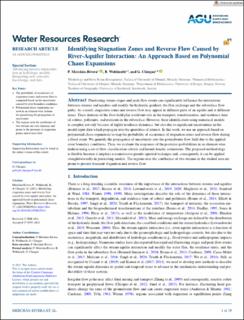Identifying Stagnation Zones and Reverse Flow Caused by River-Aquifer Interaction: An Approach Based on Polynomial Chaos Expansions
Journal article, Peer reviewed
Published version

Åpne
Permanent lenke
https://hdl.handle.net/11250/2992053Utgivelsesdato
2021Metadata
Vis full innførselSamlinger
- Department of Mathematics [939]
- Registrations from Cristin [9766]
Sammendrag
Fluctuating stream stages and peak-flow events can significantly influence the interactions between streams and aquifers and modify the hydraulic gradient, the flux exchange and the subsurface flow paths. As a result, stagnation zones and reverse flow may appear in different parts of an aquifer and at different times. These features of the flow field play a relevant role in the transport, transformation, and residence time of solutes, pollutants, and nutrients in the subsurface. However, their identification using numerical models is complex not only because of highly nonlinear dynamics, but also due to significant uncertainties in the model input data which propagate into the quantities of interest. In this work, we use an approach based on polynomial chaos expansions to map the probability of occurrence of stagnation zones and reverse flow during a flood event. We quantify the propagation of uncertainty into the groundwater flow field due to the applied river boundary conditions. Then, we evaluate the responses of the posterior probabilities in an element-wise fashion using a set of flow classification criteria and kernel density estimations. The proposed methodology is flexible because it employs a nonintrusive pseudo-spectral technique and, consequently, it can be applied straightforwardly in preexisting models. The regions near the confluence of two streams in the studied area are prone to present transient stagnation and reverse flow.
